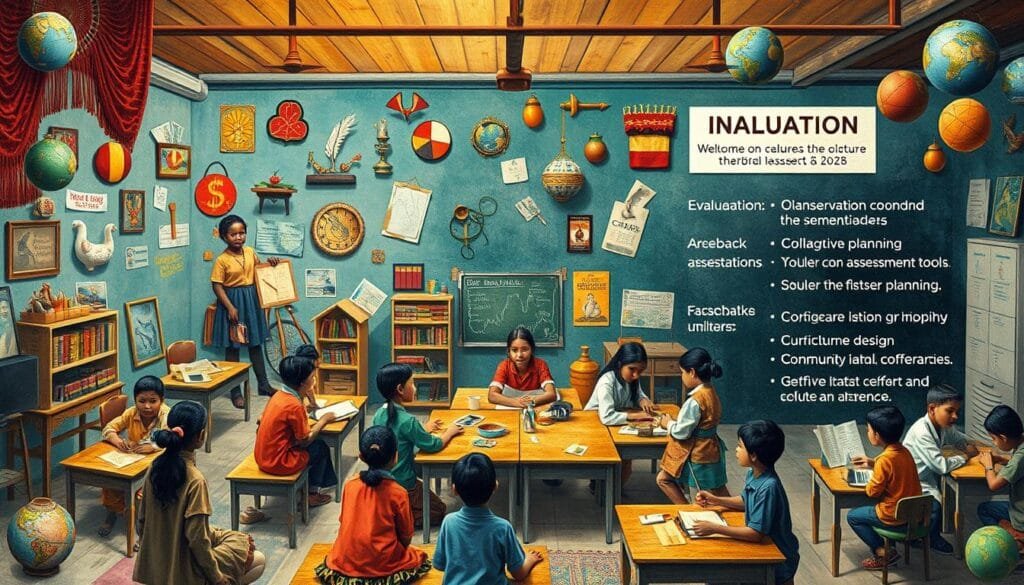Ever wondered why most literature in our schools comes from authors who don’t mirror the diverse student body? This exploration into cultural comparisons in literature aims to tackle this important question. It does so through the English arts education lens.
Often, the value of multicultural literature gets overshadowed by Eurocentric stories. A 2019 study by the NYC Coalition for Educational Justice with the NYU Metro Center found something interesting. They reviewed 1,205 English Language Arts books from grades 3-K and Pre-K to 8th. A staggering 83.2% were by white authors. Yet, white students are only 15% of the NYC student body. This shows a big mismatch in cultural representation in the curriculum.
Our guide starts a journey to fill this gap by giving teachers and students helpful tips and ideas. By bringing in a curriculum that responds to all cultures, we aim to create a welcoming space. Here, students can explore and treasure literature from various cultures.
Key Takeaways
- Diverse cultural representation in literature enriches students’ educational experiences.
- A significant majority of English Language Arts books are authored by white writers.
- Culturally responsive curriculum scorecards help evaluate the inclusivity of educational materials.
- Engaging students with multicultural literature promotes social justice and empathy.
- Educators play a critical role in bridging the cultural gap in literature.
Introduction to Comparing Cultures in English Language Arts
Starting to compare cultures in English Language Arts opens up many insights. By looking at literature from around the world, we learn different viewpoints and stories. The various backgrounds, traditions, and social rules of cultures offer rich lessons and help make literature teaching more inclusive.
Knowing the cultural background in stories helps readers understand what influences characters and plots. For example, Washington, DC, which began in the late 1700s, offers a different setting than London, which has a history of thousands of years. Also, the differences in social life, like Washington’s buzzing nightlife compared to London’s early evenings, show the varying cultural scenes.
When we look at the people living in these places, more differences stand out. In 2009, over half of Washington, DC’s population was “Black or African American,” making it a “minority majority” city. On the other hand, in 2006, about 70% of Londoners were “white” and only 10% were “black.” These numbers offer important insights for understanding how different people might see and interpret stories.
The financial differences between places also highlight cultural distinctions. Renting a one-bedroom in downtown Washington, DC costs about $1,800 monthly. In London, a similar place costs about $3,600. These economic differences shape daily life, social interactions, and even the art scenes of these cities. For instance, the presence and role of the National Gallery of Art in Washington, DC, and the Tate Modern in London, reflect their unique cultural and historical settings.
In English Language Arts, comparing cultures is crucial. It helps us understand and relate to stories from around the world better. Bringing these cultural insights into our teaching makes students more aware and appreciative of global narratives. They learn more about the world and become better at analyzing literature, all while developing cultural sensitivity.
Understanding Cultural Differences Through Literature
Diving into stories from around the world helps us recognize common themes and topics in different cultures. This understanding grows in Australian schools, where books from many cultures are now a key part of learning. This change helps fight views that only value one’s own culture and broadens students’ views of the world.

Norton’s 2009 study found that learning about global events through stories from different cultures boosts students’ world knowledge. By looking at characters from various backgrounds, such as in Jeannie Baker’s “Mirror,” we learn about different ways of life. This helps grow our cultural sensitivity.
Similarly, Evans in 2010 found that such stories make students more aware of the ways societies differ and what they value. For example, “My Two Blankets” by Irena Kobald shows the beauty of friendships that cross cultural lines. It teaches us the value of diversity in making society richer.
Stories set in different parts of the world also make us think deeply about global issues. Books like “Ziba Came on a Boat” and “Mahtab’s Story” share refugee tales. They invite readers to view these challenges through a new lens.
Also, filling school libraries with varied cultural tales, as ASLA & ALIA suggest, promotes a welcoming space for everyone. Sharing stories that students can see themselves in helps them shape their identity and feel accepted.
And by sharing classics like Fox’s “Whoever You Are,” we show kids that their feelings are universal. Tales that celebrate our differences also teach, enlighten, and build empathy. They bring us closer together, blending the many views of the world.
Practical Activities for Comparing Cultures
In English Language Arts, we get students involved in activities that compare cultures. This boosts their understanding and appreciation for different ways of life. A great tool for this is the Venn Diagram, which helps students visually compare aspects of different cultures. It’s especially useful in literature to look at traditions, music, and art from around the world.
Take, for example, comparing Halloween in the United States to Día de los Muertos in Mexico. Halloween is on October 31st, and Día de los Muertos is on November 1st and 2nd. With Venn Diagrams, students can see what these holidays share and what makes them unique. It’s a practical way to learn about different cultures.
We also use question-based learning in literature. This gets students thinking critically about cultural themes in their readings. They look into how stories show cultural identity and social class through their characters.
Our activities are designed for different ages and can last from one hour to a full year. They fit individual and group learning and can include games, roleplays, debates, projects, and more.
- Compare cultural traditions using Venn Diagrams in ELA lessons.
- Engage students in question-based exercises to enhance critical thinking.
- Design activities to fit varying classroom durations and dynamics.
| Component | Halloween (USA) | Día de los Muertos (Mexico) |
|---|---|---|
| Duration | October 31st | November 1st and 2nd |
| Major Components | Traditions, Music, Art | Traditions, Music, Art |
We see culture as more than where you come from or your family history. It’s important to focus on real understanding rather than just tests. This helps students really get the idea of intercultural competence.
Our methods, including Venn Diagrams, are all about preparing students to both know and value the world’s diverse cultures. This idea is backed by the Council of Europe. They say that the mix of cultures we encounter every day is valuable, and we must teach it carefully.
How does English language arts do cultural comparisons?
English Language Arts (ELA) uses different ways to compare cultures. It helps students understand and enjoy cultural diversity. One way is through comparing literature from around the world. Students look at classic and modern texts to find common themes and differences. This helps them see the world through various cultural lenses.

Another method is looking at common themes across different stories. For example, concepts like family, honor, or struggle are explored. This helps students see how different cultures tackle similar life challenges.
It also matters to understand the background of a story. Knowing the historical, social, and political setting of a literary work helps. For instance, comparing Civil Rights Movement literature to modern texts sheds light on ongoing issues. This shows how culture influences literature and vice versa.
Data supports the importance of these methods. The history of the Bilingual Education Act, compared to the No Child Left Behind Act, shows changes in cultural education in the U.S. Research also suggests that learning in two languages can be as effective, or more so, than learning in just one. This stresses the value of cultural diversity in education.
| Key Method | Description | Outcome |
|---|---|---|
| Comparative Literature | Analyzing literary works from different cultures | Identification of thematic similarities and differences |
| Thematic Analysis | Focusing on recurring themes across literatures | Enhanced understanding of cultural perspectives |
| Contextual Evaluations | Examining the historical, social, and political contexts | Insight into the interaction between culture and literature |
In short, ELA cultural comparison methods help students deeply understand and respect cultural diversity. These methods prepare students to live in a world that’s more connected every day.
The Role of Culturally Responsive Curriculum
Having a culturally responsive curriculum is key to making sure every student feels important and active in learning. Nowadays, students of color make up more than half of all students in public schools. Yet, 80% of teachers are white. This shows a big need for culturally responsive teaching.

Studies reveal that white teachers often expect less from Black students than from white ones. This bias can result in fewer chances for advanced classes for students of color. It can also increase suspension rates. Gloria Ladson-Billings’ idea of culturally relevant teaching has three main goals. These include improving student learning, cultural understanding, and critical awareness. All are vital for helping students of color do better in school.
Teachers who want to use this method should follow several important steps:
- Conducting a thorough curriculum evaluation to spot materials that either ignore cultural diversity or promote stereotypes.
- Adding texts and resources from many cultures so every student can see their own culture reflected.
- Expecting the best from all students, no matter their background.
- Valuing different ways of speaking and including examples from multiple cultures in lessons.
- Working with families and communities to boost student success.
Embracing this approach can make students more engaged and empathetic. It also opens them up to different viewpoints. An analysis of elementary school English/language arts shows we need more stories from marginalized cultures. This helps fight the “Rigor Gap” and ensures fair educational chances for every student.
It’s also key for teachers to reflect on their own biases and cultural viewpoints. Understanding these can help them meet their students’ varied needs more effectively. Gloria Ladson-Billings emphasizes that Culturally Responsive Teaching aims to engage students from historically marginalized groups. This approach strives for a learning environment that’s both inclusive and fair.
In the end, making your curriculum culturally responsive is about working together and staying committed. The payoff includes better grades and deeper insights into diverse cultures. It’s an essential step for any teacher wanting to offer valuable and inclusive education.
Conclusion
We’ve learned how vital it is to include many cultures in English Language Arts. We talked about why comparing cultures helps students understand and respect differences. This understanding is especially important for students from different backgrounds. For English Language Learners, things like making eye contact or asking questions depend on their culture.
Research shows a good relationship between teachers and students can boost grades by 35%. It’s key to know how culture affects behavior. For example, 25% of students might smile during serious talks as a way to show respect. And about 30% might not ask questions in class because they don’t want to seem rude.
The role of culture in learning languages is huge. Up to 70% of how well we learn a language comes from understanding its culture. Adding cultural lessons can make students 40% more interested. It can also lower cultural misunderstandings by up to 25%. This shows we need education that respects all cultures to prepare for a worldwide community.
FAQ
How do cultural themes like bravery and love differ across literary narratives?
In different cultures, themes like bravery and love are shown in unique ways. For example, in Western stories, bravery often means being a hero on your own. But in Eastern tales, it’s about working together and keeping peace in society.
Why is it important to understand the cultural context behind story settings in literature?
Knowing the cultural background of a story’s setting helps us get why characters act the way they do. It makes the story’s structure clearer. And it makes reading more enjoyable and meaningful.
How can comparing characters in literature from different cultures enhance our cultural sensitivity?
When we compare characters from different places, we see unique cultural qualities. This helps us understand and respect other ways of life. It makes us more empathetic and aware of the world’s diversity.
What are some practical activities for students to engage in cultural comparisons in literature?
Students can use Venn Diagrams to spot both similarities and differences in cultures. They can also answer questions that make them think deeply about these themes and settings. These methods make learning active and memorable.
How do Venn Diagrams help in comparative analysis of cultural elements in literature?
Venn Diagrams help students see what different cultures share and how they’re unique. This tool breaks down complex ideas. It makes comparing cultural elements simpler and clearer.
What role does a culturally responsive curriculum play in English language arts education?
A curriculum that values all cultures improves how students learn. It makes lessons more engaging. It teaches empathy and opens students’ minds to new ideas and peoples.
How can educators evaluate and implement a culturally responsive curriculum in ELA?
Teachers should look at their materials and ask diverse students for their opinions. Adding books and lessons from many cultures helps. It’s also key to embrace teaching methods that include everyone. This keeps our learning environments rich and respectful.
